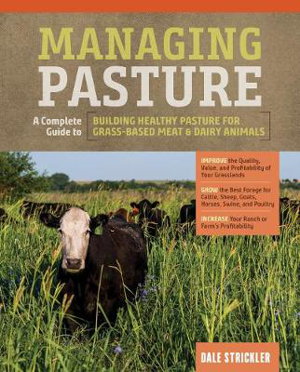| Fri | 9am – 7pm |
| Sat | 9am – 5pm |
| Sun | 10am – 5pm |
| Mon | 9am – 8pm |
| Tue | 9am – 8pm |
| Wed | 9am – 5:30pm |
| Thu | closed |
Ask our staff anything about our shop or products, or share your feedback.

PublishedStorey Publishing, May 2019 |
ISBN9781635860702 |
FormatSoftcover, 288 pages |
Dimensions26cm × 20.8cm × 2.2cm |
This in-depth handbook to improving pasture quality and soil health guides farmers seeking to establish sustainable, profitable grass-based livestock operations. The health and profitability of grass-based livestock begins with the food they eat. In Managing Pasture, author Dale Strickler guides farmers and ranchers through the practical and ideological considerations behind caring for the land as a key part of running a successful grass-based operation, from the profitability of replacing expensive grain feed with nutrient-rich native grasses to the benefits of ecologically-minded land management.
In-depth examinations of the biology and benefits of grazing plants and different grazing strategies accompany detailed plans for paddock and fencing set-ups, livestock watering, and effective methods for dealing with common pasture problems throughout the seasons, from mud to drought. For readers invested in pasture improvement strategies that offer environmental benefits beyond better meat and dairy, including carbon sequestration, erosion prevention, increased pollinator resources and wildlife habitat, and improved water quality, Managing Pasture is an approachable, accessible guide to creating and caring for the grassland that feeds animals and future generations. AUTHOR: Dale Strickler is the author of Managing Pasture and The Drought-Resilient Farm. He is a leader in the soil health movement and an agronomist for Green Cover Seed, the nation's leading cover crop-specific seed company. AUTHOR: . An approachable a guide written from personal experience. Author Dale Strickler is himself a rancher whose writing on the subject of regenerative agriculture is grounded in his personal practices and offers accessible, practical advice geared specifically to the farming audience. . Provides earth-friendly pasture improvement strategies that offer environmental benefits beyond better meat and dairy, including carbon sequestration, erosion prevention, increased pollinator resources and wildlife habitat, and improved water quality. Full-colour; photographs and illustrations throughout

